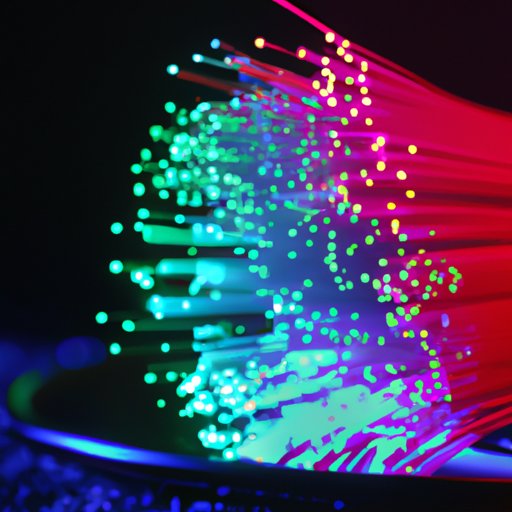Introduction
Fiber optics is a type of technology that uses light to transmit data over long distances. It is used in many different applications such as telecommunications, medical imaging, and cable television. This article will explore how does fiber optic work, from the basics to the process and components of transmission, and examine its benefits and applications.

Exploring the Basics of Fiber Optic Technology
Fiber optics is a type of technology that uses thin strands of glass or plastic to transmit light signals over long distances. These strands, called optical fibers, are capable of carrying much more data than traditional copper wires. The data is transmitted in the form of pulses of light along the length of the fiber.
The components of a fiber optic cable include the core, cladding, buffer coating, and connector. The core is the center of the fiber, made up of a material that can transmit light. The cladding is a layer of material surrounding the core, which helps keep the light from escaping. The buffer coating is a protective layer of material around the cladding. Finally, the connector is the end of the cable that connects it to other devices.
Understanding How Light Travels Through Fiber Optic Cables
The basic principle behind the transmission of light through fiber optic cables is called total internal reflection. This occurs when light rays travel through a medium with a higher refractive index, such as glass or plastic, and are reflected off the walls of the cable without any loss of energy. This allows the light to travel through the cable without any distortion and at high speeds.
There are two main types of optical fibers used in fiber optics: single-mode and multi-mode. Single-mode fibers are made up of a single strand of glass or plastic, while multi-mode fibers are made up of multiple strands. Single-mode fibers are typically used for longer distances, while multi-mode fibers are best for shorter distances.
The Process and Components of Fiber Optic Transmission
In order to transmit data over fiber optic cables, the data must first be converted into light signals. This is done with a device called a transceiver, which is connected to the end of the cable. The transceiver then sends the light signals along the length of the cable, where they are picked up by another transceiver at the other end. The transceiver at the receiving end converts the light signals back into data.
The connectors used in fiber optics are designed to provide a secure connection between the fiber optic cable and the transceiver. They come in various shapes and sizes, and each type has its own advantages. Some of the most common types of connectors are SC, ST, LC, and MTP/MPO.

An Overview of Different Types of Fiber Optic Connectors
SC connectors are the most popular type of fiber optic connectors. They are easy to use and provide a reliable connection. ST connectors are also widely used and offer good performance. LC connectors are smaller than SC and ST connectors and provide a more secure connection. Finally, MTP/MPO connectors are used for high-density applications and provide excellent performance.
Each type of connector has its own advantages and disadvantages, so it is important to choose the right one for your application. For example, SC connectors are easy to use but may not provide a secure connection, while LC connectors are more secure but may be harder to install.
Analyzing the Benefits of Fiber Optic Networking
Fiber optic networking offers many advantages over traditional copper wiring. One of the most significant benefits is increased bandwidth and speed. Fiber optic cables can carry more data than copper wires, allowing for faster transmission of information. Additionally, fiber optics are less expensive than copper cables, making them a more cost-effective option for businesses and organizations.
Another benefit of fiber optics is improved security. Fiber optic cables are more difficult to tap into than copper wires, making them more secure. Additionally, because the signal is transmitted as light, it cannot be intercepted like it can with traditional methods.

Examining Common Applications for Fiber Optic Technology
Fiber optics are used in a variety of applications, including telecommunications, medical imaging, and cable television. In telecommunications, fiber optic cables are used to connect phone networks and transfer data over long distances. In medical imaging, fiber optics are used to create images of the inside of the body. Finally, in cable television, fiber optics are used to transmit video signals.
Conclusion
This article has provided an overview of how fiber optic works, including the basics, process, components, benefits, and applications of this technology. Fiber optics is a type of technology that uses light to transmit data over long distances. It is used in many different applications such as telecommunications, medical imaging, and cable television. Fiber optics offer many advantages over traditional networking methods, including increased bandwidth, lower cost, and improved security.
(Note: Is this article not meeting your expectations? Do you have knowledge or insights to share? Unlock new opportunities and expand your reach by joining our authors team. Click Registration to join us and share your expertise with our readers.)
